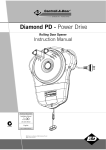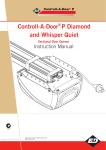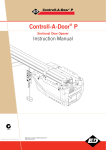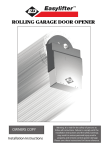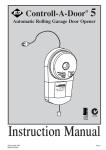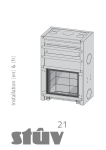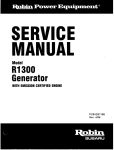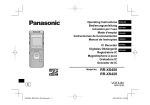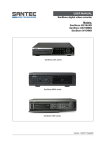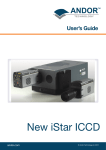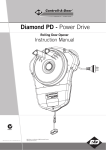Download Century 212 Automobile Accessories User Manual
Transcript
INSTRUCTIONS with 433MHz Radio Controls QLD Office: 17 Oasis Court Clontarf 4019 SA Office: (07) 3883-0200 NSW Office: 34-36 Marigold Street Revesby 2212 (02) 9722 5555 23 Frederick Road Royal Park 5014 (08) 8447 4747 WA Office: 96 Mulgul Road Malaga 6090 (08) 9247 8777 VIC/TAS Office: 147-153 Canterbury Road Kilsyth 3137 C-Tick approval logo min. size 3mm diam.; letters min. 3mm high (03) 9237 7766 B&D Doors New Zealand: 70 Allens Road EastTamaki Auckland, New Zealand (09) 273 8600 www.bnd.co.nz The Controll-A-Door-P has been tested and complies with the standards: AS/NZS 3350.2.95:2000 (incl. Amdt1) & AS/NZS CISPR 14.1:2003 N1134 TABLE OF CONTENTS Introduction Adjustment Section 2-7 Adjust the travel limits ...............................................25 Adjust the force .........................................................26 Test the safety reverse system .................................27 Testing the safety infra-red safety sensors ...............27 Safety rule review........................................................2 Preparing your garage door ........................................3 Tools needed ...............................................................3 Planning ..................................................................4-5 Carton inventory ..........................................................6 Hardware inventory .....................................................7 Assembly Operation 28-30 Operation safety instructions.....................................28 Using your garage door opener ................................28 To open the door manually........................................29 Care of your opener ..................................................29 Troubleshooting.........................................................30 8-10 Assemble the rail & attach the chain pulley bracket ...8 Install the trolley ..........................................................9 Fasten rail to motor unit ..............................................9 Install chain & attach chain spreader.....................9-10 Install the chain noise reduction pads.......................10 Installation 25-27 Programming 31 To code a hand-held remote control .........................31 To erase all codes .....................................................31 Multi-function remotes ...............................................31 11-24 Installation safety instructions....................................11 Determine the header bracket location................12-13 Install the header bracket..........................................14 Attach the rail to the header bracket.........................15 Position the opener ..............................................15-16 Hang the opener ..................................................16-17 Install the door control...............................................17 Install the remote control wall mount (optional) ........17 Wiring instructions for optional accessories..............18 Install the light globe .................................................19 Attach the emergency release rope and handle .......19 Connect electric power..............................................19 Installing the safety infra-red safety sensors.............20 Fasten the door bracket .......................................21-22 Connect door arm to trolley .................................23-24 Warranty 32 INTRODUCTION Safety Rule Review This garage door opener is designed and tested to offer safe service provided it is installed, operated, maintained and tested in strict accordance with the warnings, safety instructions and instructions contained in this manual. When you see these Safety Symbols and Signal Words on the following pages, they will alert you to the possibility of serious injury or death if you do not comply with the corresponding instructions. The hazard may come from something mechanical or from electric shock. Read the instructions carefully. WARN ARNING ING WARN ARNING ING Mechanical CAUTION WARN ARNING ING WARN ARNING ING WARN ARNING ING WARN ARNING ING Electrical When you see this Signal Word on the following pages it will alert you to the possibility of damage to your garage door and/or the garage door opener if you do not comply with the corresponding instructions. Read them carefully. WARN ARNING ING CAUTION 114A2845 WARN ARNING ING 2 Preparing your garage door WARN ARNING ING • Disable locks. Insert wood screws or nails to keep them unlocked. • Remove any ropes connected to garage door. To prevent possible SERIOUS INJURY OR DEATH: • Always call for professional B&D garage door service if garage door binds, sticks, or is out of balance. An unbalanced garage door might not reverse when required. • NEVER try to loosen, move, or adjust garage door, door springs, cables, pulleys, brackets or their hardware, all of which are under EXTREME tension. • Disable ALL locks and remove all ropes connected to garage door before installing and operating garage door opener to avoid entanglement. • This unit should not be installed in a damp or wet space. • The door must not extend over public byway during operation. • This product is provided with a power supply cord of special design which, if damaged, must be replaced by a power supply cord of the same type; such a power supply cord may be obtained from you local B&D distributor and must be fitted by a specialist. • This unit is supplied as a plug-in-device and it is strongly advised that this unit remain a plug-in device. Any alterations or changes to this will result in the opener warranty being void. CAUTION TESTING YOUR DOOR Before you begin, complete the following test to make sure your door is balanced and is not sticking or binding: • Lift the door about halfway as shown. Release the door. It should stay in place, supported entirely by its springs. • Raise and lower the door to see if there is any binding or sticking. If your door binds, sticks, or is out of balance, call for professional garage door service. WARN ARNING ING CAUTION To avoid damage to the garage door and opener, disable locks before installing and operating the opener. Use a wood screw or nail to hold locks in the "open" (unlocked) position. Operation at other than 230V/50 Hz will cause opener malfunction and damage. ONE-PIECE DOOR SECTIONAL DOOR Sectional Door Tools needed During assembly, installation and adjustment of the opener, instructions will call for hand tools as illustrated. ONE-PIECE DOOR SECTIONAL DOOR One-Piece Door PORTE ARTICULÉE PORTE RIGIDE Carpenter's Level Pencil 1 2 Hack Saw Tape Measure Wire Cutters Claw Hammer Drill PORTE ARTICULÉE 114A2845 Stepladder PORTE RIGIDE 8mm, 5mm, and 4mm Drill Bits 13mm, 11mm, and 6mm Sockets and Wrench 3 Pliers Locking pliers Screwdriver Adjustable End Wrench Planning • Do you have an access door in addition to the garage door? If not, Model T7012 Emergency Access Device is required. Identify the type and height of your garage door. Survey your garage area to see if any of the conditions below apply to your installation. Additional materials may be required. You may find it helpful to refer back to this page and the accompanying illustrations as you proceed with the installation of your opener. Depending on your requirements, there are several installation steps which may call for materials and/or hardware not included in the carton. • Installation Step 1 – Look at the wall or ceiling above the garage door. The header bracket must be securely fastened to structural supports. • Installation Step 5 – Do you have a finished ceiling in your garage? If so, a support bracket and additional fastening hardware may be required. B&D recommends the use of safety infrared reversing sensors on all installations of automatic garage door openers. and vertical reinforcement • Installation Step 10:Horizontal is needed for lightweight garage doors – Depending upon (fiberglass, garage steel, construction, extension aluminum, door with panels, etc.). be needed to brackets or woodglass blocks may See page 21 for details. install the infrared safety sensors. – Alternate floor mounting of theHeader infrared safety Wall sensors will require hardware not provided. SECTIONAL DOOR INSTALLATIONS • Do you have a steel, aluminum, fibreglass or glass panel door? If so, horizontal and vertical reinforcement is required (Installation Step 11). • The opener is normally installed at the centre of the door. If there is a torsion spring or centre bearing plate in the way of the header bracket or door bracket area, the opener may be installed within 300mm to the left or right of the door centre. See Installation Steps 1 and 11. • Look at the garage door where it meets the floor. It must close on the floor all the way across. Otherwise, the safety reverse system may not work properly. See Adjustment Step 3. Floor or door should be repaired. OPENER ARM MOUNTING LOCATION FINISHED CEILING Supportbe bracket & Must mounted on a stile. Add an additional stile if fastening hardware required or offset mount the opener (see below and is required. See page page 5).17.Attach arm 1/3 panel height from top at 10O as shown. Motor Unit Sectional Door Installation FINISHED CEILING Header Wall Support bracket & fastening hardware is required. See page 17. Extension Spring Excess MUST be removed OR Torsion Spring ——— Horizontal and vertical reinforcement is needed for lightweight garage doors (fibreglass, steel, aluminum, door with glass panels, etc.). See page 21 for details. Door Center Access Door Excess MUST be removed Motor Unit ——— 10o 10o Safety Reversing Sensor Extension Spring ——— Centre Stile optimum Safety Reversing Sensor Door location for Centre attachment Gap between floor and bottom of OR door must not exceed 6mm.Torsion Spring Access Door 1/3 Re-enforcement Must be attached below Panel Re-enforcement if used. Re-enforcement ——— CLOSED POSITION Header Bracket —— Safety Reversing Sensor Header Sleeve Bracket Trolley Rail Assembly Garage Door Spring Emergency Release Rope & Handle Gap between floor and bottom of door must not exceed 6mm. Straight Door Arm Safety Reversing Sensor Header Wall 114A2845 Panel Height —— 1/3 Panel Height 10o 4 Header Header Door Garage Bracket Bracket Sleeve Bracket Door Trolley Curved Door Arm CLOSED POSITION Rail Assembly OFF CENTRE INSTALLATION OF OPENER In situations where obstruction prevent mounting the opener centrally, offsetting the opener attachment is possible within the following range - 1/4 Door width from centre. NOTE: Even though it is acceptable practise to off centre mount the opener, the further off centre the opener is mounted the more dependent is the door operation on a good installation. This relates to correct set-up of opener and track, and correct door balance. The installation of the IR Safety Sensor is recommended for an off centre mount application. 1/4 Door Width 1/4 Door W idth ONE-PIECE DOOR INSTALLATIONS • Generally, a one-piece door does not require reinforcement. If your door is lightweight, youFINISHED can CEILING e Chamberlain Group, Inc. Support bracket refer to the information relating to sectional doors e-Piece Doorinwith TrackStep Installation (Cable -USA)& fastening Installation 11. hardware is required.One-Piece Door without Track 3/93Chamberlain The Group, on Inc. your door’sHeader construction, you See maypage 17. • Depending FINISHED CEILING Wall need additional mounting hardware for the door One-Piece Door with Track Installation (Cable -USA) Support bracket & fastening hardware is required. See page 17. bracket (Step 11). /3/93 Header • The gap between the bottom of the garage door Wall and the floor cannot exceed 6mm. Otherwise, the safety reverse system may not work properly. See Adjustment Step 3. The floor or the door should be repaired. Access Door One-Piece Door with Track Access Door Access Door Access Gap between floor and bottom Door of door must not exceed 6mm. Safety Reversing Sensor Safety Reversing Sensor Gap between floor and bottom of door must not exceed 6mm. Safety Reversing Sensor Safety Reversing Sensor Safety Reversing Sensor Safety Reversing Sensor Gap between floor and bottom of door must not exceed 6mm. Safety Reversing Sensor CLOSED POSITION Safety Reversing Sensor Gap between floor and bottom of door must not exceed 6mm. Header Sleeve Bracket Header Bracket CLOSED POSITION Header Wall Header Wall Garage Door Garage Door 114A2845 Header Sleeve Bracket Trolley Header Door Bracket Bracket Curved Straight Door Arm Door Arm Straight Door Bracket Door Arm Header Wall 5 Garage Door Header Sleeve Br Header Bracket Emergency Release Rope & Handle Trolley Rail Emergency Release Rope & Handle Rail Emergency Release Rope & Handle Chain Rail Door Bracket CLOSED POSITION Header Curved Sleeve Bracket Header Bracket Door Arm Trolley Straight Door Arm Door Bra Curved Door Arm Header Wall Gara Door Carton Inventory Hardware for assembly and installation is shown on the next page. Save the carton and packing material until installation and adjustment is complete. Your garage door opener is packaged in two cartons which contains the motor unit and the parts illustrated below. If anything is missing, carefully check the packing material. Parts may be stuck in the foam. Remote Control Transmitter Visor Clip 1-Function Remote Control Transmitter (1) Remote Control Wall Mount Bracket 3-Function Mini Remote Control Transmitter (1) Light Lens (1) Illuminated Push Button Chain Spreader with Screws and Washers Trolley Inner Trolley Chain 1-Piece Rail Bell Wire 4-Piece Rail Header Sleeve Bracket Rail Centre Section Light globe Vibration Isolators Hanging Brackets Header Bracket Door Bracket Rail Straps Safety Labels and Literature Chain Noise Reduction Pads 114A2845 6 Curved Door Arm Section Straight Door Arm Section Hardware Inventory Separate all hardware and group as shown below for the assembly and installation procedures. ASSEMBLY Washered Screw 25mm (4) (mounted in opener) Spring /Trolley Nut (1) Screw (2) Master Link (2) Carriage bolt (1) INSTALLATION Hex Screw 8mm x 20mm (4) Nut 8mm (7) Lock Washer 8mm (7) Ring Fastener (4) Lag Screw 8mm x 40mm (4) Insulated Staples Rail Grease Rope Anchors 8mm x 40mm (6) Sheet Metal Screw 8mm x 13mm (2) NOTIC E Lag Screw 8mm x 45mm (2) Screw 6AB x 25mm (2) Carriage Bolt 8mm x 65mm (2) Clevis Pin 8mm x 13mm (2) 114A2845 Handle Dry Wall Anchors (2) Clevis Pin 8mm x 25mm (2) 7 Stop Bolt (1) Clevis Pin 8mm x 32mm (1) HARDWARE SHOWN ACTUAL SIZE ASSEMBLY STEP 1 Assemble the Rail NOTE: If your opener came with a one piece rail, proceed to Assembly step 2, page 9. Grease inside edges of rail brace sections. Place rail pieces on flat surface for assembly. All four rail sections are interchangeable. Slide rail braces onto rail section. Connect rail by sliding rail brace onto next rail section. Tap rail assembly on piece of wood until rail sections are flush. Repeat with remaining rail sections. Spring Trolley Nut Carriage Bolt Install the Chain RAIL ASSEMBLY Remove chain from carton and lay chain out on floor (do not allow chain to twist). Push pins of master link bar through chain link and hole in back end of trolley. Push cap over pins and onto notches. Slide clip-on spring over cap and onto pin notches until both pins are securely locked in place. Rail Piece Insert Chain into Rail & Assemble Header Sleeve Rail Brace Slide pulley bracket and inner trolley into back (opener end) of rail assembly, be sure to insert pulley bracket as shown with arrow pointing toward front (header end) of rail. Push bracket toward front (header end) of rail. Insert carriage bolt through header sleeve bracket. Loosely thread spring nut onto carriage bolt. Insert carriage bolt of header sleeve assembly into bold cut out in pulley bracket. Slide header sleeve assembly on to front (header end) of rail. Rail Piece Grease Rail assembly INSTALLING THE CHAIN Back End of Trolley Spring Cap Chain Link Piece of Wood Master Link Bar Front (Header End) of Rail Carriage Bolt Header Sleeve Bracket Back (Opener End) of Rail Assembly Spring Nut Header Sleeve Bracket Ar ro w Carriage Bolt Pulley Bracket Pulley Bracket 114A2845 Inner Trolley 8 ASSEMBLY STEP 2 Attach Trolley to Rail Slide outer trolley into rail assembly, be sure arrow on trolley is heading in direction of door is heading in direction of door. Slide outer trolley down rail until it engages with inner trolley. Arrow Rail Assembly WARN ARNING ING Outer Trolley Arrow CAUTION To avoid serious damage to opener, ONLY use screws mounted in top of motor unit. Towards Door ASSEMBLY STEP 3 Attach Chain Spreader AVERTISSEMENT Phillips Pan Head Screws Attach chain spreader to opener with phillips pan head screws. Chain Spreader ATTENTION WARN ARNING ING WARN ARNING ING Opener To avoid possible SERIOUS INJURY to fingers from moving garage door opener: • ALWAYS keep hand clear of sprocket while operating opener. • Securely attach chain spreader before operating. CAUTION WARN ARNING ING ASSEMBLY STEP 4 Fasten Rail to Opener & Install Chain Remove four washered bolts from top of opener. Place rail on opener, flush with stops on top of opener. Wrap chain around slot in spreader and over sprocket. Push idler pulley bracket assembly toward front of the rail to eliminate excess slack in chain. Align bolt holes on brackets with bolt holes on opener. Secure brackets to opener with previously removed bolts . Tighten bolts securely. The opener sprocket teeth must engage the chain. Insert bolt into trolley stop bolt hole secure with lock washer and nut. CAUTION: Use only those bolts mounted in the top of opener. Use of any other bolts will cause serious damage to opener. Set Chain Tension Thread spring nut on carriage bolt unit finger tight. Insert a screwdriver tip into one of the slots of the nut ring and brace it firmly against the header sleeve. Place an open end wrench on the square end of the spring nut, slightly rotate nut about 1/4 turn clockwise until nut ring is released against header sleeve. This sets spring to optimum chain tension. chain may slip off sprocket if chain is too loose. If chain does slip retighten spring nut by turing nut clockwise 1/2 turn. Do NOT overtighten chain. 114A2845 9 FASTEN RAIL TO OPENER SET CHAIN TENSION Spreader Stops HARDWARE SHOWN ACTUAL SIZE Spring /Trolley Nut Washered Bolt Stops Spreader Sprocket Sprocket Nut Ring Screwdriver Tip Wrench Bolt 2 4 Trolley Stop Bolt Hole Spring Nut Lock Washer Nut Header Sleeve Lock Washer Bolt Trolley Square End Square End Nut Ring BEFORE 25mm Nut Trolley Nut Ring AFTER RELEASE 32mm Screwdriver Tip ASSEMBLY STEP 5 Nut Ring Install Chain Noise Reduction Pads (optional) Wrench 114mm Spring Nut 114mm Header Sleeve 1. Clean and remove grease from rail in areas where pads will be installed. 114A2845 2. With chain tensioned, lift up the chain and place noise reduction pads under the chain in orientation shown. 10 3. Install with adhesive side down allowing pad to stick to rail. INSTALLATION NING WARN ARNING INGINSTRUCTIONS IMPORTANT INSTALLATION ION WARN ARNING ING To reduce the risk of severe injury or death: 1. READ AND FOLLOW ALL INSTALLATION WARNINGS AND INSTRUCTIONS. 2. Install garage door opener only on properly balanced and lubricated garage door. An improperly balanced door may not reverse when required and could result in severe injury or death. 3. All repairs to cables, spring assemblies and other hardware MUST be made by a trained door systems technician before installing opener. 4. Disable all locks and remove all ropes connected to garage door before installing opener to avoid entanglement. 5. Install garage door opener 2.1m or more above floor. 6. Mount emergency release handle 1.8m feet above floor. 7. NEVER connect garage door opener to power source until instructed to do so. 114A2845 8. NEVER wear watches, rings or loose clothing while installing or servicing opener. They could be caught in garage door or opener mechanisms. 9. Install wall-mounted garage door control: • within sight of the garage door • out of reach of children at minimum height of 1.5m • away from all moving parts of the door. 10. Place entrapment warning label on wall next to garage door control. 11. Place manual release/safety reverse test label in plain view on inside of garage door. 12. Upon completion of installation, test safety reversal system. Door MUST reverse on contact with a 40mm high object on the floor. 11 INSTALLATION STEP 1 Finished Ceiling Vertical Centreline Determine the Header Bracket Location 40mm Reinforcement Board Structural Supports Header Wall Installation procedures vary according to garage door types. Follow the instructions which apply to your door. SECTIONAL DOOR A ONE-PIECE DOOR WITH WARN ARNING ING WARN ARNING ING To prevent possible SERIOUS INJURY or DEATH: • Header bracket MUST be RIGIDLY fastened to structural support on header wall or ceiling, otherwise garage door might not reverse when required. DO NOT install header bracket over drywall. • Concrete anchors MUST be used if mounting header bracket or 40mm reinforcement board into masonry. • NEVER try to loosen, move or adjust garage door, springs, cables, pulleys, brackets, or their hardware, all of which are under EXTREME tension. • ALWAYS call a trained door systems technician if garage door binds, sticks, or is out of balance. An unbalanced garage door might not reverse when required. Vertical Centreline CAUTION WARN ARNING ING Ceiling SECTIONAL DOOR AND ONE-PIECE DOOR WITH TRACK 1. Close the door and mark the inside vertical centreline of the garage door. 2. Extend the line onto the header wall above the door. NOTE: You can fasten the header bracket within 300mm of the left or right of the door center only if a torsion spring or centre bearing plate is in the way; or you can attach it to the ceiling (see page 14) when clearance is minimal. (It may be mounted on the wall upside down if necessary, to gain approximately 12mm.) If you need to install the header bracket on a 40mm reinforcement board (on wall or ceiling), use lag screws (not provided) to securely fasten the 40mm reinforcement board to structural supports as shown here and on page 13. If installing into masonry, use concrete anchors. 3. Open your door to the highest point of travel as shown. Draw an intersecting horizontal line on the header wall 50mm above the high point. This height will provide travel clearance for the top edge of the door. Header Wall 50mm 114A2845 Header Wall 50mm Highest Point of Travel Sectional door with curved Door track Trac Highest Point of Travel Door Sectional door with curved track Ceiling One-piece door with horizontal Header Wall 50mm Track Header Wall 50mm Highest Point of Travel Door Proceed to Step 2, page 14. Track One-piece door with horizontal track Sectional door with curved track 12 Track Highest Point of Travel Door One-piece door with horizontal track One Piece Door Without Track 1/30/92 - 4/7/92 ONE-PIECE DOOR WITHOUT TRACK Unfinished 1. Close the door and mark the inside vertical Ceiling 40mm centreline of your garage door. Extend the line Reinforcement onto the header wall above door, as shown. Board Header Vertical Wall If headroom clearance is minimal, you can install Centreline the header bracket on the ceiling. See page 14. If you need to install the header bracket on a 40mm reinforcement board (on wall or ceiling), Theuse Chamberlain Group, Inc. lag screws (not provided) to securely fasten the Position Header Bracket 40mm reinforcement board to structural supports Doors Without Track as shown. If installing into masonry, use concrete anchors (not provided). 1/30/92 - 4/7/92 Vertical 2. Open your door to the highest point of travel as Centreline of Garage shown. Measure the distance from the top of the Door door to the floor. Subtract the actual height of the door. Add 200mm to the remainder. (See Example). 3. Close the door and draw an intersecting horizontal line on the header wall at the determined height. If the total number of millimeters exceeds the height available in your garage, use the maximum height possible, or refer to page 14 for ceiling installation. Header Wall 40mm Reinforcement Board OPTIONAL CEILING MOUNT FOR HEADER BRACKET Highest Po of Travel Highest Point of Travel Header Wall Inc. Distance Door Door Distance EXAMPLE Distance from top of door Chamberlain Group, (at highest point of travel)The to floor ................ 2300mm Position Header Bracket Actual height of door....................................-2100mm Doors Without Track Remainder.................................................... 200mm Add............................................................... 1/30/92 - 4/7/92+200mm Bracket height on header wall ..................... =400mm (Measure UP from top of CLOSED door.) Structural Supports Jamb Hardware Pivot Proceed to Step 2, page 14. Floor One-piece door without track: jamb hardware Header Wall Highest Point of Travel Highest Point of Travel Header Wall Distance Door Jamb Hardware Distance Door Pivot Floor 114A2845 13 Floor One-piece door without track: pivot hardware INSTALLATION STEP 2 Install the Header Bracket Bracket Holes WALL HEADER BRACKET INSTALLATION Wall Mounting Holes • Centre the bracket on the vertical guideline with the bottom edge CEILING of the bracket on the horizontal line MOUNT ONLY The nail hole is for (with the arrow pointing towardpositioning the ceiling). only. You must use lag screws UP • Mark all of the bracket holes. Drill 4.5mm (3/16") to mount the header bracket. pilot holes and fasten the bracket with wood screws. For concrete mount, use concrete anchors provided. Optional Wall Mounting Holes HARDWARE SHOWN ACTUAL SIZE Bracket Holes Vertical Center Line Header Wall NLY TO G MO UN ILIN Lag Screw 8mm x 40mm CE UP 25mm Board Header Bracket Lag Screws 8mm x 40mm 25mm Board Lag Screws 8mm x 40mm Header Bracket Door Spring Anchors 8mm x 40mm – Finished Ceiling – CEILING HEADER BRACKET INSTALLATION Highest Point of Highest Point of Garage Door Travel Vertical Garagevertical Door Travel • Extend guideline onto the ceiling. Center Line 15cm Maximum • Centre the bracket on the vertical mark no more Door than 150mm (6") from the wall. Make sure the Spring arrow is pointing toward theMounting wall. Holes Ceiling • Mark all of the bracket holes Drill 4.5mm (3/16") CEILING (5). MOUNT ONLY pilot holes and fasten the bracket with wood screws. For concrete ceiling mount, use concrete UP anchors provided. The nail hole is for Garage Door Header Bracket Vertical Centreline UP 50mm (2") Garage Door positioning only. You must use lag screws to mount the header bracket. Vertical Centre Line Header Wall Garage Door Lag Screws 8mm x 40mm Vertical Centre Line Header Wall Vertical Centreline – Finished Ceiling – Bracket Holes Header Bracket Vertical Centreline 150mm (6") Door Spring Lag Screws 8mm x 40mm Bracket Holes Header Wall 114A2845 14 INSTALLATION STEP 3 Attach the Rail to the Header Bracket • Position opener on garage floor below the header bracket. Use packing material to protect the cover. Raise rail until holes in the header sleeve and holes in the header bracket align. Join with clevis pins. Insert ring fasteners to secure. NOTE: To enable the rail to clear sectional door springs, it may be necessary to lift opener onto a temporary support. The opener must either be secured to a support or held firmly in place by another person. Header Wall Header Bracket Ring Fastener Header Sleeve Bracket Ring Fastener Clevis Pin 8mm x 13mm Clevis Pin 8mm x 13mm Clevis PIn 8mm x 13mm (2) Header Sleeve Bracket Rail Garage Door Ring fastener (2) HARDWARE SHOWN ACTUAL SIZE Temporary Support INSTALLATION STEP 4 Position the Opener Follow instructions which apply to your door type as illustrated. SECTIONAL DOOR OR ONE-PIECE DOOR WITH TRACK A 25 mm board laid flat is convenient for setting an ideal door-to-rail distance. • Raise the opener onto a stepladder. You will need help at this point if the ladder is not tall enough. • Open the door all the way and place a 25mm board laid flat on the top section beneath the rail. • If the top section or panel hits the trolley when you raise the door, pull down on the trolley release arm to disconnect inner and outer sections. Slide the outer trolley toward the motor unit. The trolley can remain disconnected until Installation Step 12 is completed. WARN ARNING ING CAUTION ENGAGED 114A2845 To prevent damage to garage door, rest garage door opener rail on 25mm board or equivalent placed on top section of door. Trolley Release Arm RELEASED 15 Rail Door 25mm Board laid flat Door ONE-PIECE DOOR WITHOUT TRACK • With the door fully open and parallel to the floor, measure the distance from the floor to the top of the door. • Using a stepladder as a support, raise the top of the opener to this height. • The top of the door should be level with the top of the motor unit. Do not position the opener more than 50mm above this point. Rail 25mm Board laid flat Door Header Bracket Top of Motor Unit Top of door Header Bracket WARN ARNING ING Top of Motor Unit Top of doorSERIOUS INJURY from a falling To avoid possible garage door opener, fasten it SECURELY to structural supports of the garage. Concrete anchors MUST be used if installing any brackets into masonry. CAUTION INSTALLATION STEP 5 Hang the Opener The opener must be securely fastened to a structural support of the garage. Two representative installations are shown. Yours may be different. Hanging brackets should be angled (Figure 1) to provide rigid support. On finished ceilings, (Figure 2) attach a sturdy metal bracket (not supplied) to a structural support before installing the opener. 1. On each side of opener measure the distance from the opener to the structural support (or ceiling). 2. Cut both pieces of the hanging bracket to required lengths. Flatten one end of each bracket and bend or twist to fit the fastening angles. Do not bend at the bracket holes. Drill 4.5mm (3/16") pilot holes in the structural supports (or ceiling). Attach flattened ends of brackets to supports with wood screws. 3. Lift opener and fasten to hanging brackets with screw, lock washer and nut. Check to make sure rail is centered over the door. 4. Remove 25mm (1") board. Operate door manually. If door hits the rail, raise header bracket. 5. Use rail grease and lubricate inside surface of rail. Structural FigureSupports 1 Structural Supports Lag Screws 8mm x 45mm 1 Lag Screws 8mm x 45mm Figure 2 Hidden Support Hidden Support Bracket (Not provided) Lag Screws 8mm x 45mm Lag Screws 8mm x 45mm 114A2845 Lock Washer 8mm Measure Screw 8mm Distance Nut 8mm FINISHED CEILING Lag Screw 8mm x 45mm Nut 8mm Measure Distance Lock Washer 8mm Screw 8mm Nut 8mm HARDWARE SHOWN ACTUAL SIZE Hex Screw 8mm x 20mm 1 FINISHED CEILING Bracket (Not provided) Lock Washer 8mm Screw 8mm Nut 8mm Lock Washer 8mm Screw 8mm Nut 8mm Lock Washer 8mm 16 INSTALLATION STEP 6 Lighted Door Control Button Terminal Screws Install the door control Bell Wire WHT -2 Locate the door control within sight of the door at a minimum height of 1.5m where small children cannot reach, and away from all moving parts of the door and door hardware. 1. Strip 6mm of insulation from one end of the bell wire. Connect it to the two screw terminals on the back of the door control by color: white wire to 2 and white/red wire to 1. 2. Fasten the Lighted Door Control Button securely with 6ABx1-1/2” screws. If installing into drywall, drill 4mm holes and use the anchors provided. 3. Run the bell wire up the wall and across the ceiling to the opener. Use insulated staples to secure the wire in several places. Do not pierce wire with a staple, creating a short or open circuit. 4. Receiver terminals are located on the back panel of the opener. 5. Strip 11mm of insulation from the end of the bell wire and insert in wire trap: white to 2 and white/red to 1. 6. Permanently attach the entrapment warning label to the wall near the door control, and the manual release/safety reverse test in a prominent location on the inside of the garage door. RED -1 Lighted Door Control Button HARDWARE SHOWN ACTUAL SIZE Screw 6ABx1-1/2” Lighted Door Control Button Remote Control Wall Mount (optional) 1. Locate wall mount bracket at least 1.5m above the floor. 2. Attach to the wall with 2 x ø 3.5 max flat head screws (not provided). 3. Slide remote control onto wall mount bracket. NOTE: Tightening the wall mount screws will reduce clearance between bracket and wall. 114A2845 Bell Wire 17 Drywall Anchors Insulated Staples WARN ARNING ING WARNING WIRING INSTRUCTIONS FOR ACCESSORIES To prevent possible SERIOUS INJURY or DEATH from electrocution: • Be sure power is not connected BEFORE installing door control. To prevent possible SERIOUS INJURY or DEATH from a closing garage door: • Install door control within sight of garage door, out of reach of children at a minimum height of 1.5m, and away from all moving parts of door. • NEVER permit children to operate or play with door control push buttons or remote control transmitters. • Activate door ONLY when it can be seen clearly, is properly adjusted, and there are no obstructions to door travel. • ALWAYS keep garage door in sight until completely closed. NEVER permit anyone to cross path of closing garage door. AVERTISSEMENT • Place entrapment warning label on the inside of door as a reminder of safe operating procedures. Place the manual release/safety reverse test label in plain view on the inside of the garage door. AVERTISSEMENT KEY SWITCH MODEL 059009 To opener terminal: white to 2; white/red to 1. SAFETY INFRARED REVERSING SENSOR MODEL 062153 To opener terminal screws: white to 2; Black to 3. DOOR CONTROL PANEL 062159 To opener terminal: white to 2; white/red to 1. INSTALLATION STEP 7 Install the Light • Press the release tabs on both sides of lens. Gently rotate lens back and downward until the lens hinge is in the fully open position. Do not remove the lens. Install a 40 watt maximum (socket size E27), light globe in the socket as shown. • The light will turn on and remain lit for 2-1/2 minutes when power is connected. After 2-1/2 minutes it will turn off. • Reverse the procedure to close the lens. Replace burned out globes with rough service light globes. 114A2845 40W Max Light Globe Release tabs of lens Socket 18 WARN ARNING ING INSTALLATION STEP 8 Attach the Emergency Release Rope and Handle • To prevent possible SERIOUS INJURY or DEATH from a falling garage door: – If possible, use emergency release handle to disengage trolley ONLY when garage door is CLOSED. Weak or broken springs or unbalanced door could result in an open door falling rapidly and/or unexpectedly. – NEVER use emergency release handle unless garage doorway is clear of persons and obstructions. • NEVER use handle to pull door open or closed. If rope knot becomes untied, you could fall. CAUTION • Thread one end of the rope through the hole in the top of the red handle so "NOTICE" reads right side up as shown. Secure with an overhand knot at least 25mm from the end of the rope to prevent slipping. • Thread the other end of the rope through the hole in the release arm of the outer trolley. • Adjust rope length so the handle is 1.8m above the floor. Secure with an overhand knot. If it is necessary to cut the rope, heat seal the cut end with a match or lighter to prevent unraveling. Overhand Knot Trolley Trolley Release Arm Rope NOT ICE WARN ARNING ING STEP 9 INSTALLATION WARN ARNING ING Connect Electric Power To prevent possible SERIOUS INJURY or DEATH from electrocution or fire: • Be sure power is not connected to the opener, and disconnect power to circuit BEFORE removing cover to establish permanent wiring connection. • Garage door installation and wiring MUST be in compliance with all local electrical and building codes. • NEVER use an extension cord, 2-wire adapter, or change plug in any way to make it fit outlet. Be sure the opener is earthed. CAUTION WARN ARNING ING To avoid installation difficulties, do not run the opener at this time. Connect the operator to a mains which is properly earthed according to the wiring instruction tag attached to the power supply cord (and as specified by local code). 114A2845 Emergency Release Handle 19 The units must be installed inside the garage so that the sending and receiving eyes face each other across the door, between 100-150mm above the floor. Either can be installed on the left or right of the door as long as the sun never shines directly into the receiving eye lens. The brackets must be securely fastened to a solid surface such as the wall framing. If installing in masonry construction, add a piece of wood at each location to avoid drilling extra holes in masonry if repositioning is necessary. The invisible light beam path must be unobstructed. No part of the garage door (or door tracks, springs, hinges, rollers or other hardware) may interrupt the beam while the door is closing. INSTALLATION STEP 10 Install the Safety Infrared Reversing Sensors (Optional) It is recommended that safety infrared reversing sensors be connected and aligned correctly to the garage door opener. The force, as measured on the closing edge of the door, should not exceed 400N (40kg). If the force is adjusted to more than 400N, this Theclosing Chamberlain Group, Inc. safety system must be installed. Safety Sensor IMPORTANT INFORMATION ABOUT Instruction Sheet Page 1 THE SAFETY REVERSING SENSORS Protector System Disk #1and (Yellow) When properly connected aligned, the safety infrared reversing sensors will detect an obstacle in 11/5/91 - 1/15/92 the path of its electronic beam. The sending eye transmits an invisible light beam to the receiving eye. If an obstruction breaks the light beam while the door is closing, the door will stop and reverse to full open position, and the opener light will flash 10 times. Sensor Beam 100-150mm max. above floor Sensor Beam 100-150mm max. above floor Invisible Light Beam Protection Area Facing the door from inside the garage Note: This operator, when used with safety reversing sensor 062153, meets product standard requirements for a monitored sensor system. If the operator detects that the safety sensors no longer function properly, the operator will not close until the sensor continuity has been returned. 114A2845 20 WARN ARNING ING CAUTION INSTALLATION STEP 11 Fasten the Door Bracket Fibreglass, aluminum or lightweight steel garage doors WILL REQUIRE reinforcement BEFORE installation of door bracket. To prevent damage to garage doors reinforce inside of door with angle iron both vertically and horizontally. Follow instructions which apply to your door type as illustrated below or on the following page. A horizontal reinforcement brace should be long enough to be secured to two or three vertical supports. A vertical reinforcement brace should cover the height of the top panel. Figure 1 shows one piece of angle iron as the horizontal brace. For the vertical brace, two pieces of angle iron are used to create a U-shaped support. The best solution is to check with your garage door manufacturer for an opener installation door reinforcement kit. NOTE: Many door reinforcement kits provide for direct attachment of the clevis pin and door arm. In this case you will not need the door bracket; proceed to Step 12. HARDWARE SHOWN ACTUAL SIZE Carriage Bolt 8mm x 65mm Nut 8mm Lock Washer 8mm SECTIONAL DOORS Sheet Metal Screw 1. Centre the door bracket on the previously marked vertical centreline used for the header bracket installation. Note correct UP placement, as Figure 1 stamped inside the bracket. Vertical Vertical 2. Position the top edge of the bracket 50mm Reinforcement Reinforcement 100mm (2"-4") below the top edge of the door, OR Vertical Vertical Vertical Reinforcement directly below any structural support across the top Centreline Reinforcement Vertical of Garage Door Vertical of the door. Centreline Centreline of Garage Door Vertical of Garage Door Bolt 3. Mark, drill holes and install as follows, depending Centreline 8mm x 65mm of Garage Door on your door’s construction: Bolt UP Metal or light weight doors using a vertical angle iron brace between the door panel support and Door Bracket the door bracket: Door Self-Threading • Drill 4.5mm (3/16") fastening holes. Secure the Screw Bracket 8mm x 13mm Self-Threading door bracket using the two 8mm x 13mm (1/4"Screw 14x5/8") self-threading screws. (Figure 2A) 8mm x 13mm • Alternately, use two 8mm (5/16") bolts, lock Figure 2A washers and nuts. (Figure 2B) Metal, insulated or light weight factory reinforced doors: • Drill 4.5mm (3/16") fastening holes. Secure the door bracket using the self-threading screws. (Figure 3) UP UP Figure 2B Inside Edge of Door or Reinforcement Board Bolt 8mm x 65mm Vertical Centreline of Garage Door UP Wood Doors: • Use top and bottom or side to side door bracket holes. Drill 8mm (5/16") holes through the door and secure bracket with 8mm x 65mm (5/16"x2") carriage bolts, lock HARDWARE washers and nuts (not SHOWN ACTUAL SIZE provided). (Figure 4) NOTE: The 8mm x 13mm (1/4"-14x5/8") self-threading Self-Threading Screw screws are not intended for 8mm x 13mm use on wood doors. Self-Threading Screw Vertical Centreline of Garage Door Self-Threading Screw 8mm x 13mm UP Self-Threading Screw 8mm x 13mm Figure 3 1/4"-14x5/8" 114A2845 UP 8mm x 65mm Door Bracket Door Lock Washer 8mm Bracket Nut Lock Washer 8mm 8mm Nut 8mm 21 Inside Edge of Door or Reinforcement Board Bolt 8mm x 65mm UP Vertical Centreline of Garage Door UP Vertical Figure Centreline of Garage Door 4 ONE-PIECE DOORS Please read and comply with the warnings and reinforcement instructions on the previous page. They apply to one-piece doors also. • Centre the door bracket on the top of the door, in line with the header bracket as shown. Mark either the left and right, or the top and bottom holes. • Metal Doors: Drill 4.5mm (3/16") pilot holes and fasten the bracket with the 8 x 13mm (1/4"14x5/8") self-threading screws provided. • Wood Doors: Drill 8mm (5/16") holes and use 8mm x 2" (5/16"x2") carriage bolts, lock washers and nuts or 8 x 40mm (5/16"x1-1/2") lag screws depending on your installation needs. NOTE: The door bracket may be installed on the top edge of the door if required for your installation. (Refer to the dotted line optional placement drawing.) HARDWARE SHOWN ACTUAL SIZE Carriage Bolt 8mm x 65mm Nut 8mm Lock Washer 8mm Sheet Metal Screw Self-Threading Screw 1/4"-14x5/8" Header Wall 2x4 Support Finished Ceiling Door Bracket Top of Door (Inside Garage) Top Edge of Door Header Bracket Optional Placement Door Bracket METAL DOOR Optional Placement of Door Bracket Vertical Centreline of Garage Door HORIZONTAL AND VERTICAL REINFORCEMENT IS NEEDED FOR LIGHTWEIGHT GARAGE DOORS (FIBREGLASS, ALUMINUM, STEEL, DOORS WITH GLASS PANEL, ETC.). (NOT PROVIDED) Nut 5/16"-18 Door Bracket Lock Washer 5/16" Top of Door (Inside Garage) Top Edge of Door Optional Placement Carriage Bolt 5/16"x2" (Not Provided) For a door with no exposed framing, or for the optional installation, use lag screws 5/16"x1-1/2" (Not Provided) to fasten door bracket. 114A2845 22 WOOD DOOR INSTALLATION STEP 12 Inner Trolley Connect Door Arm to Trolley Outer Trolley Follow instructions which apply to your door type as illustrated below and on the following page. SECTIONAL DOORS ONLY • Make sure garage door is fully closed. Pull the emergency release handle to disconnect the outer trolley from the inner trolley. Slide the outer trolley back (away from the door) about 200mm as shown in Figures 1, 2 and 3. Ring Fastener Clevis Pin 8mm x 25mm Straight Door Arm Door Bracket Figure 1: • Fasten straight door arm section to outer trolley with the 8mm x 25mm clevis pin. Secure the connection with a ring fastener. • Fasten curved section to the door bracket in the same way, using the 8mmx 32mm clevis pin. Curved Door Arm Clevis Pin 8mm x 32mm Figure 1 Figure 2: • Bring arm sections together. Find two pairs of holes that line up and join sections. If possible, use the top and bottom holes on the curved door arm, as shown. Figure 3, Hole Alignment Alternative: • If holes in curved arm are above holes in straight arm, disconnect straight arm. Cut about 150mm from the solid end. Reconnect to trolley with cut end down as shown. • Bring arm sections together. • Find two pairs of holes that line up and join with screws, lock washers and nuts. • Pull the emergency release handle toward the opener at a 45° angle so that the trolley release arm is horizontal. Proceed to Adjustment Step 1, page 25. Trolley will re-engage automatically when opener is operated. Lock Washers 8mm Nuts 8mm Emergency Release Handle Hex Screws 8mm x 20mm Door Bracket Figure 2 HARDWARE SHOWN ACTUAL SIZE Lock Washers 8mm Nut 8mm Lock Washer 8mm Clevis Pin 8mm x 25mm (Trolley) Nuts 8mm Ring Fastener Hex Screws 8mm x 20mm Hex Screw 8mm x 20mm Cut This End Figure 3 Clevis Pin 8mm x 32mm (Door Bracket) 114A2845 23 ALL ONE-PIECE DOORS Door Bracket Assemble the Door Arm: • Fasten the straight and curved door arm sections together to the longest possible length (with a 2 or 3 hole overlap). • With the door closed, connect the straight door arm section to the door bracket with the 8mm x 32mm clevis pin. • Secure with a ring fastener. Ring Fastener Lock Washers 8mm Clevis Pin 8mm x 32mm Nuts 8mm Straight Arm Screws 8mm x 20mm Curved Door Arm • Press the Remote Control transmitter button. The Adjustment Procedures for One-Piece Doors trolley will travel to the fully closed position. On one-piece doors, before connecting the door arm • Manually close the door and lift the door arm to the to the trolley, the travel limits must be adjusted. Limit trolley. The arm should touch the trolley just ahead adjustment screws are located on the left side panel of the door arm connector hole. Refer to the fully as shown on page 25. Follow adjustment procedures closed trolley/door arm positions in the illustration. below. If the arm is behind the connector hole, adjust the A. Open Door Adjustment: Decrease UP limit further. One full turn equals 50mm of trolley Travel Limit travel. Fully Closed Door • Turn the UP limit adjustment screw counterConnect the door arm to the trolley. Trolley Bracket Ring clockwise 4 1/2 turns. Fastener • Close the door and join the curved arm to the Nuts Door Arm button. The • Press the Remote Control transmitter connector hole in the trolley withLock the remaining 8mm Connector Hole Washers trolley will travel to the fully open position. clevis pin. It may be necessary to lift the door 8mm Door Arm Straight slightly the connection. Clevis Pin to make • Manually raise the door to the open position Arm 8mm x 25mm (parallel to the floor), and lift the door arm to the • Secure with a ring fastener. Emergency Release Handle Screws trolley. The arm should touch the trolley just in Curved 8mmthrough x 20mm a complete travel cycle. • Run the opener If Door Arm back of the door arm connector hole. Refer to the the door has a slight "backward" slant in full open fully open trolley/door Closed arm positions in the position as shown in the illustration, decrease the Door not extend far enough, illustration. If the arm does UP limit until the door is parallel to the floor. adjust the limit further. One full turn equals 50mm NOTE: When setting the up limit on the following of trolley travel. page, the door should not have a "backward" slant B. Closed Door Adjustment: Decrease DOWN when fully open as illustrated below. A slight Fully Open Travel Limit backward slant will cause unnecessary bucking Trolley • Turn the DOWN limit adjustment screw clockwise and/or jerking operation as the door is being opened 4 complete turns. or closed from the fully open position. Correct Angle Door Arm Connector Hole Fully Closed Trolley Door Arm Connector Hole Door Arm Door with Backward Slant (Undesirable) Open Door Door Arm Emergency Release Handle Closed Door Fully Open Trolley Correct Angle Door with Backward Slant (Undesirable) Open Door 114A2845 24 Door Arm Connector Hole Door Arm WARN ARNING ING ADJUSTMENT STEP 1 Limit Adjustment Without a properly installed safety reversal system, persons (particularly small children) could be SERIOUSLY INJURED or KILLED by a closing garage door. • Incorrect adjustment of garage door travel limits will interfere with proper operation of safety reversal system. • If one control (force or travel limits) is adjusted, the other control may also need adjustment. • After ANY adjustments are made, the safety reversal system MUST be tested. Door MUST reverse on contact with 40mm high object on floor. CAUTION Run the opener through a complete travel cycle. Force adjustments are not necessary when the door opens and closes completely and doesn't reverse unintentionally in the fully closed position. Locate the button on the back panel of motor unit. NOTE: if the operator stops or reverses and will not allow the run through of a complete travel cycle, it may be necessary for the operator to adjust the force profile. WARN ARNING ING Push the button twice to enter into Force Setting Mode. Proceed with limit setting. NOTE: Repeated operation of the opener during adjustment procedures may cause motor to overheat and shut off. Allow a 15 minute cooling period after 5 continuous operations of the opener. Read the following carefully before proceeding to Force Adjustment. Use a screwdriver to make limit adjustments. If Door Doesn't Open Completely but Opens at Least 1.5m (5 feet): Increase up travel. Turn the up limit adjustment screw clockwise. One turn equals 5cm (2") of travel. If door does not open at least 1.5m (5 feet). Adjust force, see Force Adjustment: Place the opener into the Force Adjustment Mode, see Force Adjustment. If Door Doesn't Close Completely: If door arm is at maximum length, increase down travel. Turn down limit adjustment screw counterclockwise. One turn equals 5cm (2") of travel. If the door still will not close completely, the header bracket is positioned too high. If Opener Reverses in Fully Closed Position: Decrease down travel. Turn down limit adjustment screw clockwise. One turn equals 5cm (2") of travel. If Door Reverses when Closing and there is no Interference to Travel Cycle: Test door for binding. Pull manual release handle. Manually open and close door. If door is binding, call a door serviceman. If door is not binding or unbalanced, place the opener into the Force Setting Mode, see Force Settings. PROCEED TO “FORCE SETTINGS” TO COMPLETE STEP “LIMIT ADJUSTMENT”. Forces must be learned in order for limit adjustments to operate properly. 114A2845 CAUTION To prevent damage to vehicles, be sure fully open door provides adequate clearance. Limit Adjustment Screws 25 ADJUSTMENT STEP 2 WARN ARNING ING Adjust the Force The force, as measured on the closing edge of the door, should not exceed 400N (40kg). If the closing force is measured to more than 400N, a Safety Infrared Reversing Sensor must be installed See step 3 on page 27. The force setting button is located on the back panel of the motor unit. The force setting regulates the- SEARS Adjust Force amount of power required to open and close the door. If the forces are too light, door travel may be interrupted by nuisance reversals. Locate the button on the back panel of motor unit. Push the button twice to enter into Force Setting Mode. The LED (Indicator Light) will flash. Push the wall control or the programmed remote control that was shipped with your opener. The door will travel to either the OPEN or CLOSE position. Push the button again, the door will travel to the opposite position. Push the button again if the LED is stilling blinking. The door must travel through a complete cycle UP and DOWN in order for the force to be set properly. If the unit reverses before it reaches the Open or Close Limit repeat the process. The LED (indicator light) will stop flashing when the force has been learned. Without a properly installed safety reversal system, persons (particularly small children) could be SERIOUSLY INJURED or KILLED by a closing garage door. • Too much force on garage door will interfere with proper operation of safety reversal system. • NEVER increase force beyond minimum amount required to close garage door. • NEVER use force adjustments to compensate for a binding or sticking garage door. • If one control (force or travel limits) is adjusted, the other control may also need adjustment. • After ANY adjustments are made, the safety reversal system MUST be tested. Door MUST reverse on contact with 40mm high object on floor. • The force, as measured on the closing edge ot the door, should not exceed 400N (40kg). If the closing force is more than 400N, a Safety Infrared Reversing Sensor must be installed. Do not use the force setting procedure to compensate for a binding or sticking garage door. Excessive force will interfere with the proper operation of the Safety Reverse System or damage the garage door. CAUTION Note: If unable to set limits return to page 25. Button Button Press 2 times 114A2845 26 Step 3 Test Safety Reverse System SEARS 315-699 (Yellow Disk #2) Models 53315, 53415, 535156, 53625 & 53699 ADJUSTMENT STEP 3 WARN ARNING ING 6/20/89 - 6/27/89 Test the Safety Reverse System Without a properly installed safety reversal system, persons (particularly small children) could be SERIOUSLY INJURED or KILLED by a closing garage door. • Safety reversal system MUST be tested every month. • If one control (force or travel limits) is adjusted, the other control may also need adjustment. • After ANY adjustments are made, the safety reversal system MUST be tested. Door MUST reverse on contact with 40mm high object on the floor. CAUTION TEST • With the door fully open, place a 40mm board on the floor, centered under the garage door. • Operate the door in the down direction. The door must reverse on striking the obstruction. ADJUST • If the door stops on the obstruction, it is not traveling far enough in the down direction. Increase the DOWN limit by turning the DOWN limit adjustment screw counterclockwise 1/4 turn. NOTE: On a sectional door, make sure limit adjustments do not force the door arm beyond a straight up and down position. See the illustration on page 23. • Repeat the test. • When the door reverses on the 40mm board, remove the obstruction and run the opener through 3 or 4 complete travel cycles to test adjustment. If the door will not reverse on the board after repeated adjustment attempts, call for professional B&D garage door service. IMPORTANT SAFETY CHECK: Repeat Adjustment Steps 1, 2 and 4 after: • Each adjustment of door arm length, limits, or force controls. The Chamberlain Group, Inc. • Any repair to or adjustment of the garage door Safety Sensor (including springs and hardware). Instruction SheetofPage 1 floor. • Any repair to or buckling the garage • Any repair to or adjustment of the#1 opener. Protector System Disk (Yellow) GARAGE DOOR 40mm board laid flat 11/5/91 - 1/15/92 WARN ARNING ING ADJUSTMENT STEP 4 Without a properly installed safety reversing sensor, persons (particularly small children) could be SERIOUSLY INJURED or KILLED by a closing garage door. The force, as measured on the closing edge ot the door, should not exceed 400N (40kg). If the closing force is more than 400N, the Safety Infrared Reversing Sensor must be installed. Do not use the force setting procedure to compensate for a binding or sticking garage door. Excessive force will interfere with the proper operation of the Safety Reverse System or damage the garage door. Test the Safety Infrared Reversing Sensors (if installed) CAUTION • Press the remote control push button to open the door. • Place the opener carton in the path of the door. • Press the remote control push button to close the door. The door will not move more than 25mm, and the door control will blink 10 times. The garage door opener will not close from a remote if the indicator light in either sensor is off (alerting you to the fact that the sensor is misaligned or obstructed). If the opener closes the door when the safety reversing sensor is obstructed (and the sensors are no more than 150mm above the floor), call for professional B&D garage door service. Safety Reversing Sensor 114A2845 27 Safety Reversing Sensor OPERATION NING WARN ARNING ING IMPORTANT SAFETY INSTRUCTIONS WARN ARNING ING To reduce the risk of severe injury or death: TION ION 1. READ AND FOLLOW ALL WARNINGS AND INSTRUCTIONS. 2. ALWAYS keep remote controls out of reach of children. NEVER permit children to operate or play with garage door control push buttons or remote controls. 3. ONLY activate garage door when it can be seen clearly, it is properly adjusted, and there are no obstructions to door travel. 4. ALWAYS keep garage door in sight until completely closed. NO ONE SHOULD CROSS THE PATH OF THE MOVING DOOR. 5. If possible, use emergency release handle to disengage trolley ONLY when garage door is CLOSED. Weak or broken springs or unbalanced door could result in an open door falling rapidly and/or unexpectedly. 6. NEVER use emergency release handle unless garage doorway is clear of persons and obstructions. 7. NEVER use handle to pull garage door open or closed. If rope knot becomes untied, you could fall. 8. If one control (force or travel limits) is adjusted, the other control may also need adjustment. 9. After ANY adjustments are made, the safety reversal system MUST be tested. 10. Safety reversal system MUST be tested every month. Garage door MUST reverse on contact with 40mm high object on the floor. 11. ALWAYS KEEP GARAGE DOOR PROPERLY BALANCED (see page 3). An improperly balanced door may not reverse when required and could result in severe injury or death. 12. All repairs to cables, spring assemblies and other hardware, all of which are under EXTREME tension, MUST be made by a trained door systems technician. 13. ALWAYS disconnect electric power to garage door opener before making any repairs or removing covers. 14. The force, as measured on the closing edge ot the door, should not exceed 400N (40kg). If the closing force is more than 400N, a Safety Infrared Reversing Sensor must be installed. Do not use the force setting procedure to compensate for a binding or sticking garage door. Excessive force will interfere with the proper operation of the Safety Reverse System or damage the garage door. 15. When the opener is activated: 1. If open, the door will close. If closed, it will open. 2. If closing, the door will stop and reverse. 3. If opening, the door will stop. 4. If the door has been stopped in a partially open position, it will close. 5. If obstructed while closing, the door will reverse. If the obstruction interrupts the sensor beam, the opener lights will blink for five seconds. 6. If obstructed while opening, the door will stop. 7. If fully open and the Infrared Safety Reversing Sensor is installed, the door will not close when the beam is broken. The sensor has no effect in the opening cycle. The opener light will turn on under the following conditions: when the opener is initially plugged in; when power is restored after interruption; when the opener is activated. It will turn off automatically after 2-1/2 minutes. Globe power is 40 watts maximum. Using Your Garage Door Opener Your opener will operate with up to twelve remote control transmitters, one entry keypad, and one dipswitch code transmitter. If you purchase a new remote, or if you wish to deactivate any remote, follow the instructions in the Programming section. Activate your opener with any of the following: • The hand-held Remote Control: Hold the large push button down until the door starts to move. • The wall-mounted Door Control: Hold the push button down until the door starts to move. • The Keyless Entry (Optional): Must be programmed before use. 114A2845 SAVE THESE INSTRUCTIONS. 28 To Open the Door Manually Care of Your Opener LIMIT AND FORCE ADJUSTMENTS: Weather conditions may Limit Controls cause some minor changes in door operation requiring some re-adjustments, particularly during the first year of Adjustment Label operation. (Located on the left side panel) Pages 25 and 26 refer to the limit and force adjustments. Force Controls Repeat the safety reverse test (Adjustment Step 3, page 27) after any adjustment of limits or force. WARN ARNING ING Emergency Release Handle (Pull Down) WARN ARNING ING • To Trolley prevent possible SERIOUS INJURY or DEATH from Releasegarage door: a falling Arm – If possible, use emergency release handle to disengage trolley ONLY when garage door is CLOSED. Weak or broken springs or unbalanced door could result in an open door falling rapidly and/or unexpectedly. – Trolley NEVER use emergency release handle unless garage doorway is clear of persons and obstructions. Release Trolley Arm • NEVER use handle to pull door open or closed. If rope Release knotArm becomes untied, you could fall. CAUTION WARN ARNING ING NO TIC E 9 Emergency Release Handle NO TIC E (Pull Down) Emergency Release Handle (Pull Down & Back DISCONNECT NOTICE Towards Opener) 1 7 MAINTENANCE SCHEDULE NO TIC E Emergency Release NO TIC Handle E Emergency (Pull Down) Release Handle TROLLEY: (Pull Down & Back Towards Opener) TO RE-CONNECT THE Pull the emergency release handle toward the opener at a 45° degree angle so that the trolley release arm is horizontal. The trolley will reconnect on the next UP or DOWN operation, either manually or by using the door control or remote. Arm 3 5 5 KG KG THE REMOTE CONTROL BATTERY The lithium battery should produce power for up to 5 years. To replace battery, use the visor clip or screwdriver blade to pry open the case. Insert battery positive side up. Dispose of old battery properly. NOTICE WARN ARNING ING To reconnect To prevent possible SERIOUS INJURY or DEATH: • NEVER allow small children near batteries. • If battery is swallowed, immediately notify doctor. CAUTION 114A2845 1 7 NOTICE Trolley Release Arm Emergency Release Handle (Pull Down & Back Towards Opener) 9 Adjustment Label Once a Month (Located on the back panel) • Manually operate door. If it is unbalanced or binding, call for professional garage door service. • Check to be sure door opens & closes fully. Adjust limits and/or force if necessary. (See pages 25 and 26.) • Repeat the safety reverse test. Make any necessary adjustments. (See Adjustment Step 3.) Twice a Year • Check chain tension. Disconnect trolley first. Adjust if necessary (see page 11). Once a Year • Oil door rollers, bearings and hinges. The opener does not require additional lubrication. Do not grease the door tracks. • Lubricate the chain. THE TROLLEY: The door should be fully closed if possible. Pull down on theTrolley emergency release Release handle Arm(so that the trolley Trolley release arm snaps into a Release Emergency Arm Emergency Release Handlevertical position) and lift the Release (Pull Down & Back door manually. The lockout Handle Towards Opener) feature prevents the trolley (Pull Down) from reconnecting automatically, and the door Lockout position can be raised and lowered (Manual disconnect) Trolley manually as often as Trolley Release Release necessary. Arm NOTICE 3 29 Troubleshooting 1. Opener doesn't operate from either door control or remote: • Does the opener have electric power? Plug lamp into outlet. If it doesn't light, check the fuse box or the circuit breaker. (Some outlets are controlled by a wall switch.) • Have you disengaged all door locks? Review installation instruction warnings on page 1. • Is there a build-up of ice or snow under door? The door may be frozen to ground. Remove any obstruction. • The garage door spring may be broken. Have it replaced. • Repeated operation may have tripped the overload protector in the motor. Wait 15 minutes. Try again. 2. Opener operates from remote but not from door control: • Is door control button lit? If not, remove the bell wire from the opener terminals. Short the red and white terminals by touching both terminals at the same time with a piece of wire. If the opener runs, check for a faulty wire connection at the door control, a short under the staples, or a broken wire. • Are wiring connections correct? Review page 3. 3. Door operates from door control but not from remote: • Check battery. Replace battery if necessary. • Is the light at the wall control flashing? Press button with key-symbol to unlock the opener against remote controls. • Is the receiver LED flashing at the back-side of the opener when the transmitter is pressed? The opener receiver must re-learn the remote control code. Follow the instructions on page 4. • If you purchased a new remote control then check at carton of remote control for compatibility or call the Service Hotline. 4. Remote has short range: • Is battery installed? If needed, change the battery. • Change the location of the remote control on the car. • A metal garage door, foil-backed insulation or metal siding will reduce the transmission range. • Use outside coaxial antenna adapter to move antenna. 5. Door reverses for no apparent reason and opener light doesn't blink: • Is something obstructing the door? Pull manual release handle. Operate door manually. If it is unbalanced or binding, call for professional garage door service. • Clear any ice or snow from garage floor area where garage door closes. • Review Force Settings. Open and close the door in learn mode for several (3-5) consecutive cycles to allow the operator to adjust to inconsistent doors. • If door reverses in FULLY CLOSED position, re-learn travel limits. Repeat safety reverse test after adjustment is complete. The need for occasional adjustment of the force and limit settings is normal. Weather conditions in particular can affect door travel. 6. Door reverses for no apparent reason and opener light blinks for 5 seconds after reversing: Check The Safety Infrared Reversing Sensor (if you have installed this accessory). If the light is blinking, correct alignment. Note: Continuously holding down the door control button will allow the door to close if the protector system is not properly aligned. The transmitter will not close the door. The opener lights will blink. 114A2845 30 7. Opener noise is disturbing in living quarters of home: If operational noise is a problem because of proximity of the opener to the living quarters, Vibration Isolator Kit 062155 (included with the operator) can be installed. This kit was designed to reduce the "sounding board effect" and is easy to install. 8. The garage door opens and closes by itself: • Delete all remote controls and reprogram. • Make sure remote push button is not stuck "on". • Disconnect all push buttons or key switches attached and wait one day. 9. Door stops but doesn't close completely: Review Limit Adjustment section. Repeat safety reverse test after any adjustment of door arm length, close force or down limit. 10. Door opens but won't close: • Check The Safety Infrared Reversing Sensor (if you have installed this accessory). If the light is blinking, correct alignment. • If opener light does not blink and it is a new installation, check the down force. Repeat the safety reverse test after the adjustment is complete. 11. Opener light does not turn on: Replace light bulb (40 Watts maximum). Replace burned out bulbs with rough service light bulbs. 12. Opener light does not turn off: There may be a defective earth at the ceiling or wall receptacle. The unit must be earthed. 13. Opener strains or reversed during opening: Door may be unbalanced or springs are broken. Close door and use manual release rope and handle to disconnect trolley. Open and close door manually. A properly balanced door will stay in any point of travel while being supported entirely by its springs. If it does not, call for professional garage door service to correct the problem. Do not change force settings. 14. Opener motor hums briefly, then won't work: • Garage door springs are broken. SEE ABOVE. • If problem occurs on first operation of opener, door is locked. Disable door lock. If chain was removed and reinstalled, the motor may be out of phase. Remove chain; cycle motor to down position. Observe drive sprocket. When it turns in clockwise direction and stops in down position, re-install chain. Repeat safety reverse test after adjustment is complete. 15. Opener won't activate due to power failure: • Pull manual release rope and handle down and back to disconnect trolley. Door can be opened and closed manually. When the power is restored, pull the manual release handle straight down. The next time the opener is activated, the trolley will reconnect. • The Outside Quick Release accessory (if fitted) disconnects the trolley from outside the garage in case of power failure. 9 1 7 9 3 1 7 5 3 5 KG KG PROGRAMMING SPECIFICATIONS Below are instructions for programming your opener to operate with remote control transmitters. Horsepower ....................1/2 Rated Pull Force.............800N Stand-by power rating @ 230V...........................5.5W 9 9 1 7 3 5 USING THE “SMART” BUTTON 9 1 7 9 3 1. Press and hold the button on the hand-held remote* that you wish to operate your garage door. L ift M 3 5 2. Press and release the “Learn” button on the back panel of the opener. KG as te as te r te 1 7 3 5 KG L ift M as te Receiver Operating Frequency......433.92MHz Computer Codes ............8 Code Switch Code..........1 Keypad Code..................1 r r To deactivate any unwanted remote, first erase all codes: Press and hold the “Learn” button on opener until the smart indicator light goes out (approximately 6 seconds). All previous codes are now erased. Reprogram each remote or keyless entry you wish to use. *Multi-Function Remotes If provided with your garage door opener, the large button is factory programmed to operate it. Additional buttons on any multifunction remote or mini-remote can be programmed to operate other garage door openers. 114A2845 9 Dimensions Length (Overall)..............3.1m (122-1/2") Headroom Required .......5cm (2") Hanging Weight ..............14.5 kg (32 lb) To Erase All Codes From Opener Receiver Memory as 3 5 KG Safety Personal..........................Push button and stop. Push button and automatic reversal in down direction. Push button and automatic stop in up direction. Electronic ........................Independent up and down force adjustment screws. Electrical .........................Motor overload protector and low voltage push button wiring. Limit Device ....................Circuit actuated by limit nut. Limit Adjustment .............Screwdriver adjustment on side panel. Start Circuit.....................Low voltage push button circuit. r L ift M 1 7 Drive Mechanism Gears ..............................16:1 worm gear reduction Drive ...............................Chain with one-piece trolley on steel C-rail. Length of Travel..............Adjustable to 2.29m (7-1/2 feet) Travel Rate .....................127mm (5") per second Lamp...............................On when door starts, off 2-1/2 minutes after stop. Door Linkage ..................Adjustable door arm. Pull cord trolley release. 1 7 5 KG 9 Motor Type ................................Permanent split capacitor Speed .............................1500 rpm Volts ................................230-240 Volts AC-50Hz Only Current............................2.0 amperes KG L if t M 3 5 KG To Code a Hand-held Remote Control Transmitter 3. The light bulb will blink when the code has been accepted. If light bulb is not installed, two clicks will be heard. 1 7 31 WARRANTY Controll-A-Door® Automatic Garage Door Opener 1. Definitions ‘B&D’ means (a) in Australia - B&D Doors of 17 Oasis Court Clontarf, Queensland 4019 (b) in New Zealand - B&D Doors (NZ) Ltd of 70 Allens Road East Tamaki Auckland, which is a subsidiary of Alesco NZ Ltd. ‘Purchaser’ means the purchaser of the Opener. ‘Opener’ means the ‘Controll-A-Door Automatic Garage Door Opener’ ‘Approved Distributor’ means an approved B&D distributor of the Opener. ‘Major Components’ means all components of the Opener that make up the power head (including any track assembly, if any), that is attached to a garage door. ‘Ancillary Components’ means all components of the Opener which are not Major Components. ‘Manufacturer’s Written Instruction Manual’ means the instruction manual provided with the Opener. 2. This warranty applies to every sale of an Opener to a Purchaser by B&D or its Approved Distributor, and is the only warranty given on behalf of B&D. 3. B&D warrants that it will, at its option, either repair or replace any defects: (i) in materials or workmanship in the Opener, subject to the following: (a) for Major Components of the Opener that are installed by B&D or an Approved Distributor the warranty shall be valid for a period of sixty (60) months; (b) for Major Components of the Opener that are not installed by B&D or an Approved Distributor the warranty shall be valid for a period of twelve (12) months, provided that all costs of disconnection, reinstallation and freight shall be borne by the Purchaser. (c) for Ancillary Components of the Opener the warranty shall be valid for a period of twelve (12) months. Globes and batteries excluded. (ii) in installation for a period of twelve (12) months from the date of installation where the Opener has been installed by B&D or its Approved Distributor. 4. The warranties provided in clause 3(i) shall only apply to an Opener which is being used under normal use and service in accordance with the Manufacturer’s Written Instruction Manual and are limited to the repair or replacement, at B&D’s option, of any defective Opener or parts thereof. 5. The warranty provided in clause 3(i) shall apply from: (i) the date of delivery of the Opener by B&D; or (ii) the date of installation of the Opener by B&D or one of its Approved Installers; or (iii) the date of purchase of the Opener by the Purchaser; whichever is the later. 6. (i) Where the Opener has been sold to the Purchaser by B&D, the Purchaser shall make all warranty claims hereunder directly with B&D; (ii) Where the Opener has been sold to the Purchaser by an Approved Distributor, the Purchaser shall make all warranty claims hereunder directly with the Approved Distributor. 7. The Purchaser will pay for any service call made by B&D or an Approved Distributor where such a call is made for the purpose of adjustment (as described in the Manufacturers Written Instruction Manual) and not for rectification of a defect pursuant to the warranty hereunder. 8. (i) The Purchaser shall be responsible for any expense incurred by B&D or an Approved Distributor in ensuring that the Opener is readily accessible for any repair work carried out under this warranty. (ii) Where an Opener is installed outside a capital city metropolitan area and a warranty claim is made pursuant to this warranty, any travelling expenses and costs of transporting the Opener, incurred by B&D or its Approved Distributor, shall be borne by the Purchaser. 9. Subject to paragraph 12 hereof; (i) the obligations of B&D under this warranty are limited to those contained herein and such warranties are expressly in lieu of all other warranties, express or implied, including any implied warranty of merchantability or fitness for a particular purpose and notwithstanding any course of dealing between the parties or custom and usage in the trade to the contrary. (ii) B&D shall not be subject to nor incur and the Purchaser releases B&D from any claim or liability (including consequential loss or damage and loss or use or profit) by reason of delay, defective or faulty materials or workmanship, negligence or any act, matter or thing done, admitted or omitted by B&D. 114A2845 10. Subject to Clause 12 hereof, this warranty does not extend to and B&D will be relieved of all obligations, responsibilities and liabilities (direct or consequential) in the event that defects in manufacture of the Opener are directly or indirectly in the opinion of B&D due to or result from: (i) being fitted to any door or other closing device which is not of the type or condition defined in the Manufacturers Written Instruction Manual as suitable for installation of the Opener. (ii) Lack of proper maintenance or care of the Door and Opener. Door must be serviced in accordance to the door’s care and maintenance instructions. Failure to maintain the door may result in the opener warranty being voided. (iii) Incorrect and unreasonable use. (iv) Faulty installation or adjustment of the Opener or door to which the Opener is connected where such installation or adjustment is not carried out by B&D or one of its Authorised B&D Distributors. (v) Failure to observe any instructions or directions provided with the Opener or given to the Purchaser by B&D or an Approved Distributor. (vi) Modifications or repairs made or attempted to be made by any unauthorised person. (vii) Faulty electrical wiring of structures to which the Opener is affixed. (viii) Radio (including citizen brand transmissions) or other electronic interference. (ix) Water damage, including effects from rust and corrosion. (x) Use with doors locked. (xi) Operation of the opener with excessively high opening or closing force settings. 11. The warranty contained in Clause 3 does not cover batteries or globes and B&D shall not be liable for any defect, malfunction or failure of such items. 12. It is expressly provided that the warranties or any terms and conditions of them or other statement contained in this document or other literature given to the Purchaser shall not be read or applied so as to purport to exclude, restrict or modify or have the effect of excluding, restricting or modifying the application in relation to the supply of the Opener of all or any of the provisions of Divisions 2 and 2A of Part V of the Trade Practices Act, 1974, or the Consumer Guarantees Act 1993 if the purchase is a ‘consumer’ and purchased the opener in New Zealand, (“The Act”) as amended or the exercise of a right conferred by such a provision or any other condition or warranty implied by any relevant State Act or Territorial Ordinance or by the general law and which by law cannot be excluded, restricted or modified provided that to the extent that the Act permits B&D to limit its liability for a breach of condition or warranty implied by the Act, B&D’s liability for such breach shall be limited to the payment of the cost of replacing the Opener or acquiring an equivalent Opener or repairing the Opener. 13. This warranty shall be governed by and construed in accordance with Australian law if the opener was purchased in Australia, or New Zealand law if the opener was purchased in New Zealand. 14. Upon making a claim under this warranty the purchaser must produce proof of the date of purchase, together with the warranty certificate set out below: Purchased from: Installed by: Installed on (date): The Purchaser shall complete this certificate and keep it together with a copy of the receipt of purchase in a safe place – production of such information will assist the handling of a claim made under this warranty. The B&D Diamond and Controll-A-Door are registered Trademarks of B&D Australia Pty Ltd., an Alesco company. ABN 25010473971. ©2005, All Rights Reserved Printed in Mexico
































